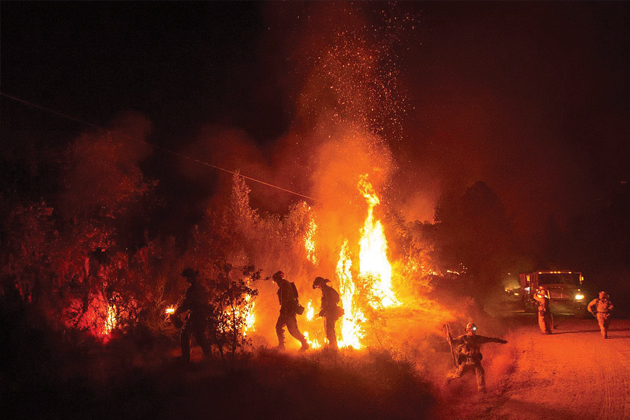
Forests comprise nearly one-third of the total land area of the United States. Although beautiful and serene, forested terrain can turn deadly when wildfire season strikes. According to the U.S. Forest Service (USFS), the 2015 wildfire season was the costliest on record, with more than $2 billion spent fighting fires. During one week alone last summer, firefighting cost $1.6 million per
hour. “Most of the fires in 2015 hit western states like drought-stricken California, where fire risk remains high due to four years of drought that has resulted in the deaths of millions of trees,” reported Zoё Hoyle, a writer and researcher with the USFS.
A record 10.1 million acres burned in 2015, surpassing the previous high of 9.8 million acres in 2006. It was the fourth year in the last decade in which more than nine million acres burned. Most of the fires have occurred in Alaska and the western states, with California and Colorado hit especially hard. Insurance claims in these states and others have been staggering. For example, according to Aon Benfield, the Valley Fire northwest of San Francisco and the Butte Fire southeast of Sacramento, both in September, racked up combined economic losses of $2 billion and insured losses of about $1.3 billion.
“The severity of the September wildfires in California serves as a reminder of how costly the peril can be for the insurance industry,” said Adam Podlaha, head of impact forecasting for Aon Benfield. “With insurers facing more than $1 billion in claims payouts for the Valley and Butte fires alone, it makes it the costliest year for the peril since 2007.”
As a result, some insurance companies have stopped writing policies for homeowners in high-risk wildfire areas, forcing them to take out higher-priced policies with companies that insure unusual risks, such as Lloyd’s of London. With predictions of hotter temperatures and increased drought conditions in coming years, fire conditions are generally expected to worsen, which will make it even more difficult (and more expensive) for homeowners and business owners to purchase coverage in areas prone to wildfires. What’s more, as businesses expand into wildland-urban interfaces, where more forested land is present, the risk to businesses grows as well. To protect employees and assets and reduce insurance costs, businesses need to implement a well-thought-out, comprehensive wildfire mitigation plan.
Understanding the Risk
While wildfires are inevitable, wildfire disasters are not. It is quite possible for a wildfire to sweep over commercial buildings and do minimal damage. But for that to happen, business owners must design and implement an effective wildfire mitigation plan. This proactive approach gives them the best chance of protecting employees, maintaining business continuity and minimizing financial losses.
Buildings burn when there is enough contact with flames, radiant heat or burning embers to ignite the structure. According to the Insurance Institute for Business and Home Safety (IBHS), burning embers (also called firebrands), particularly those that are wind-blown, are the most frequent cause of building ignitions. Embers can also be carried long distances by winds and land on roofs or enter vents, causing damage in areas thought to be less vulnerable or past the danger. This happened in 2015 in Wenatchee, Washington, where wind-carried embers ignited several buildings in the city’s commercial district.
Mitigation strategies for businesses and commercial properties in high-risk wildfire areas are not that much different than strategies for homes—for example, top priorities include selecting fire-resistant construction and building materials and removing flammable vegetation from the perimeter of the structure.
The first step for businesses is understanding their Fire Hazard Severity Zone (FHSZ) rating. This rating can be obtained from local building or fire officials and is based on the property’s fire history and the plants, landscaping, slope and other terrain features that could impact the growth and spread of fire. Fire hazard severity is typically classified as “moderate,” “high” or “extreme.”
“Be sure to comply with any local requirements for your building code and property,” said Molly Mowery, a wildfire mitigation expert and president/owner of Wildfire Planning International, a Denver-based consulting firm. “For any new construction or retrofits that you’re planning, check with your community development department to see if you need to follow specific mitigation requirements for approval of your development application.”
It is also a good idea to consult with the local fire department to understand its size and capabilities, such as how long it will take firefighters to arrive in an emergency.
Designing a Mitigation Strategy
Having the most wildfire-resistant building starts with construction. California’s fire-resistant-construction guidelines are often considered to be the gold standard for constructing fire-resistant buildings. The roof is typically the top concern—because it is a large, relatively horizontal surface, it is one of the most vulnerable parts of a building during wildfire, especially for ember exposure. The best protection is a Class A roof, which must be able to withstand severe fire tests to receive this rating. “For low-slope roofs, a Class A-rated roof includes testing and rating of the entire roof system assembly, which includes the roof cover, insulation, vapor or air barriers, and the type of deck,” IBHS reports. “Class A-rated steep-slope roof coverings include asphalt composition shingles, clay tile and steel.”
Exterior walls built from noncombustible materials such as concrete and brick provide the greatest protection against flames, embers and radiant heat. IBHS indicates that the distance between the ground and the bottom of the siding on the exterior wall also affects a building’s vulnerability, particularly when walls are made of materials that can ignite. Building codes generally call for six inches of clearance between the ground and the start of the siding.
Windows and vents are also vulnerable during a fire. Dual-paned windows with tempered glass have the best chance of remaining intact and keeping embers out. Vents should be covered with noncombustible mesh screening to prevent embers from entering attic or crawlspace areas. According to the IBHS, vents that are perpendicular to the flow of wind—such as gable-end vents or those in under-eave blocking—are more vulnerable to ember entry. “Ridge vents that are rated to resist the entry of wind-driven rain or vents in boxed-in, under-eave construction are better options,” IBHS said.
It is also important to ensure a noncombustible, defensible space around your business by keeping the perimeter clear of flammable materials, especially plants and landscaping materials. Maintaining this space is essential for reducing the possibility of the building catching fire, especially as it keeps flames and radiant heat away from the side of the building.
The most critical zone is up to five feet from the exterior wall—also called the near-building, noncombustible or low-combustible zone. Keeping this zone clear of combustibles reduces the chance that flames will come into direct contact with the exterior of the building. Woody vegetation should not be used in this zone, and IBHS advises using noncombustible mulches, such as rock mulch.
Not maintaining this zone can greatly increase fire risk. Defensible space zones can be extended outward from the building 50 feet or more, depending on vulnerability. A larger defensible space is needed for properties on a slope, as wildfire often travels faster up an incline than across flat ground.
Creating a larger defensible space also includes removing flammable materials stored beside or near commercial buildings, such as lumber, rubber tires, packing and shipping crates, or propane tanks. “Commercial industries that store flammable materials outdoors should assess their vulnerability to traveling embers and consider storage options to protect these potential ignition sources,” Mowery said.
The number-one priority with a wildfire mitigation plan, however, should always be the safety of employees. It is sometimes easier to focus on mitigating danger to structures and material assets, but this risks overlooking the most important asset a company has—its employees. Therefore, it is important to design a safety, evacuation and recovery strategy as part of the overall wildfire mitigation plan.
“Think of wildfire evacuation in terms of different time scenarios—15 hours, 15 minutes, 15 seconds,” Mowery said. “What would you do under each scenario? How would you alert colleagues and share this information? We often assume we’ll be clear-minded and able to make rational decisions, but during stressful events, this can be difficult. Develop and practice your plan so that everyone knows how to implement it effectively before the event occurs.”
Preparing for the Future
As temperatures rise and precipitation patterns shift because of climate change, it is likely that drought—and associated disasters like wildfires—will only get worse across many areas of the United States. “Large stand-level changes in forests are already underway in many parts of the West, but all U.S. forests can be impacted by drought,” Hoyle said.
Climate patterns suggest that wildfire seasons are becoming hotter, longer and more severe. Over the past 10 years, Georgia, Florida, Texas, Colorado, Utah, California and several other states have experienced the most destructive fires in their histories. As wildfire severity increases, the Forest Service will consume more resources fighting them, making it harder to take on other critical work such as restoration, which is critical to reducing wildfire threats in the first place.
Businesses that move into higher-risk wildland-urban interfaces in particular should work with qualified wildfire mitigation experts to help assess their property and its unique features to make the most accurate determination of the threat to the business. It is essential to work with someone who understands the complexities of risk, fire behavior and wildfire mitigation. These experts are available through local fire departments and state forestry agencies or as third-party wildfire mitigation specialists.
Too often, however, business owners lose interest in the wildfire mitigation plan once it has been implemented. Wildfire mitigation needs to be an ongoing process and it is critical to maintain good mitigation and disaster preparedness practices. These include business continuity plans, evacuation plans, backup and offsite storage of data, proper insurance, and post-fire recovery plans. “These best practices are essential for those who face wildfire as a potential threat,” Mowery said. “Even if you don’t think you are in a high-risk FHSZ, it is still important to have a complete understanding of your property’s risk.”
Some insurance companies, such as AIG’s Private Client Group, offer personal wildfire protection programs for policyholders in select high-risk wildfire areas in the western United States. The goal is to pre-empt wildfire damage before it occurs. The company will send its own wildfire protection specialists to assess a property’s vulnerability to wildfire and take action to mitigate the risk. “If warranted, they can apply Phos-Chek—the same environmentally friendly fire retardant used by the U.S. Forest Service—around the perimeter of the property,” AIG says. “The retardant creates an added layer of protection that can last throughout wildfire season. During a wildfire, our goal is to dispatch wildfire-mitigation specialists to the affected area. If access is permitted, wildfire mitigation specialists will visit vulnerable properties and, when necessary, apply Class A foam or Phos-Chek.”
Although blanket mitigation standards may be easier to implement, they might not be appropriate for all situations. For example, requirements that focus primarily on a specified distance between structures and all vegetation may overlook other important aspects, such as the proximity of other structures (outbuildings and garages) to the main commercial structure, differing uses and large acreage. Professional mitigation specialists can help business owners explore these nuances to create a more effective risk-reduction plan.
Even the best mitigation plan is not a guarantee in the face of unpredictable wildfires. “However, mitigation practices based on sound science have given us plenty of examples across the country that show how effective mitigation saves property,” Mowery said. “There is no reason not to take action before a fire—it is the best defense for saving lives, saving your business and providing peace of mind.

